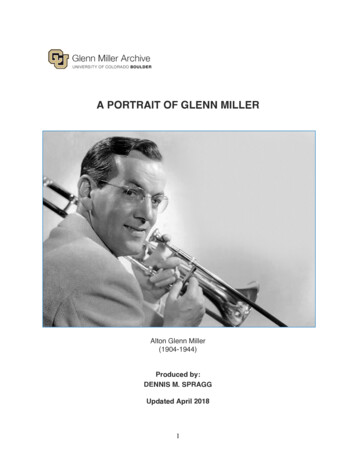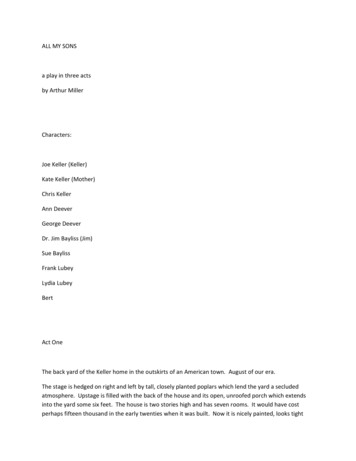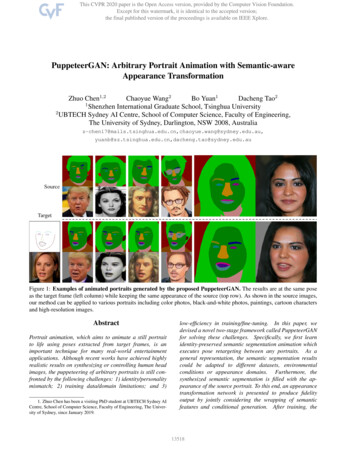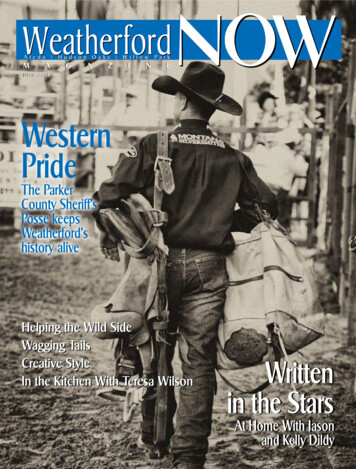
Transcription
A PORTRAIT OF GLENN MILLERAlton Glenn Miller(1904-1944)Produced by:DENNIS M. SPRAGGUpdated April 20181
Alton Glenn Miller, 1904-1944Produced by Dennis M. Spragg, with commentary from the GMA George T. Simon (1912-2001)Collection and Papers, Edward F. Polic Papers and Christopher Way Collection.ForewordBy Harry Lillis “Bing” Crosby (1904-1977)“As the years go by, I am increasingly grateful that I was a tiny part of the era of the great swingbands. This was the golden age of popular music for me. They were all great, but I have to thinkthat the Glenn Miller band was the greatest. Unlike so many of the others, Glenn was not avirtuoso instrumental soloist. And so instead of his horn he did it with great personnel andinnovative harmonic experiments producing a sound that was his and his alone. Glenn employeda harmonization that was new and vastly different. If I even attempted a description of what hedid, I would be immediately adrift. I think it was the way he voiced his instruments. It was justbeautiful. And when you heard the sound, it was recognizable and memorable. It was just GlennMiller. Glenn as a person was just as memorable. He was a very good personal friend, from theearly days on, ever since he performed on some of the records I made with the Dorsey BrothersOrchestra during the early stages of my career. During World War II we were united for the lasttime, when I sang in London with his great AAF Orchestra. About the best thing I can rememberabout Glenn, personally, was his innate taste and class. He loved good things, musically, and inhis personal life. Although he came from Colorado, I believe his taste in clothes and life-stylewas definitely Ivy League. A most attractive man, and, of course, tremendously gifted. I haveno doubt, had he lived, he would have been a tremendous force in the popular music in the yearsto come, not that he wasn’t already. It is unfortunate that he isn’t with us here today.”Bing Crosby wrote a letter of recommendation for Glenn Miller to the United States Navy in1942 when Miller applied for a commission as an officer. Miller would ultimately join theUnited States Army and be assigned to the Army Air Forces. George T. Simon’s biography andBing’s comments about Glenn Miller are included in the foreword of Simon’s 1974 book “GlennMiller and his Orchestra,” by George T. Simon (Thomas W. Crowell, New York). The book,manuscript and research notes are among the GMA George T. Simon Collection and Papers.2
Bing Crosby and Maj. Glenn Miller, London, August 31, 1944(Courtesy of Edward F. Polic)IntroductionLate one cold and wet evening in an attic room of an old house in Bedford, England, fifty miles north ofLondon, Major Glenn Miller was visiting with two of his bandsmen, arranger Jerry Gray and string bassplayer Trigger Alpert. They had been talking about Glenn’s civilian band, in which these two sergeantshad played such important roles. And they were talking about the new days, the “now” days in whichthey were playing for the Allied troops in England, and the days to come when the band would fly to theContinent, entertain the troops and ultimately return to America. Glenn would settle on his Californiaranch and the band would work hard for six months out of the year, relax for the other six. Everybodywould make plenty of money and be very satisfied. Major Miller returned later that evening to the MountRoyal Hotel in London, where he was billeted. He spoke with his executive officer, Lt. Don Haynes, whohad been Glenn’s personal manager during their civilian careers.3
They, too, talked about the future; more specifically, about the immediate plans for moving their sixtytwo soldier aggregation to Paris, and who was going to do what. Originally, Haynes had been slated tofly to Paris ahead of the group to find accommodations for the men. But Glenn was facing seriousdeadlines with the preparations for broadcasting facilities and his commanding officer, Lt. Col. DavidNiven, had ordered Glenn to come ahead of the band instead of Don to complete the arrangements.Haynes would come over with the band a few days later. The weather was miserable on both December13 and December 14 when Glenn attempted to travel on the daily Air Transport Command passengerservice for VIPs from Bovingdon to Paris Orly aerodrome. The flights were canceled due to the weatheron the continent and Glenn could not obtain a seat until at least December 17. On the afternoon ofDecember 14, an impatient Miller accepted an invitation to accompany an acquaintance, Lt. Col. NormanF. Baessell on an Eighth Air Force Service Command flight from RAF Twinwood, near Bedford, toVillacoublay aerodrome near Paris. The plane was a single-engine Noorduyn C-64 Norsemanliaison/utility aircraft, piloted by Flight Officer John R. S. Morgan. The weather was wet and cold butacceptable for local flying in England. The pilot was not cleared for an IFR (instrument) flight above theweather to France because the Paris area forecast was problematic. Lt. Col. Baessell was a senior officialand he directed the pilot to proceed via CFR (contact, or visual) flight below the weather. The overcastcloud cover would drop considerably by the time the aircraft reached the English Channel and the aircraftwould be exposed to serious icing conditions. As the C-64 was about to depart, Miller yelled to Baessell(over the noise of the idling engine) “where the hell are the parachutes?” “What’s the matter, Miller,”retorted the gung-ho, extroverted colonel to the obviously apprehensive major, “do you want to liveforever?”Early Years“I couldn’t stand the name Alton. I can still hear my mother calling for me across the field, ‘Al-ton’, itwas never ‘Awl-ton.’ I just hated the sound of that name. That’s why I’ve always used Glenninstead.” That is how Alton Glenn Miller, born March 1, 1904 at 601 South 16thStreet in Clarinda, a verysmall town tucked in the southwest corner of Iowa, would explain why the country’s number one bandwas not Alton Miller’s. Miller was the second born child of Lewis Elmer Miller and Mattie Lou(Cavender) Miller. His older brother was Dr. Elmer Deane Miller (1901-1971). His younger siblingswere John Herbert Miller (1913-1987) and Emma Irene (Miller) Wolfe (1916-1999). At the age of five,Glenn’s family moved to Tryon, Nebraska. His father worked in nearby North Platte. In 1913 the familymoved to Grant City, Missouri. In 1918, the family moved to Fort Morgan, Colorado. Glenn playedfootball in high school, played trombone and had unimpressive grades, except for Math and Latin. Uponhis 1921 graduation, he had become so immersed in music that he skipped the ceremonies and traveled toLaramie, Wyoming for a band job that failed to materialize. His mother accepted his diploma from theprincipal, who commented “maybe you are the one who should get this anyway; you probably workedharder on it than he did.”4
Twenty months after high school graduation, Glenn matriculated to the University of Colorado, with anengagement as trombonist in the band of Boyd Senter in between. In Boulder, Glenn spent a great deal oftime with a band led by Holly Moyer, a fellow student. Glenn learned much about style, grooming andpresentation from Moyer, a World War I Navy veteran; lessons that he would put into practice with hisown bands. Glenn would leave school to tour with the popular southwestern band of Jimmy Joy(Maloney); he returned but then dropped out for good, working with Moyer again, as well as TommyWatkins, touring south to Mexico and west to California. Eventually he landed in Los Angeles and wentto work for Max Fischer’s band at the Forum Theatre. It was there that he would get the break that was tochange his entire musical career and his entire life. He was hired by bandleader Ben Pollack. ThePollack band was one of the most influential and idolized bands of its day. The band was filled withyoung, jazz-oriented musicians, including Bix Beiderbecke and Benny Goodman, who became Glenn’sroommate. Pollack hired Glenn Miller as much for his interest in arranging as to be a tromboneplayer. The Pollack band would work primarily in Chicago, where it was a smash at the Blackhawk andrecorded for Victor records. In March 1928, the Pollack band went east to New York where its successcontinued.During this period, Glenn maintained a long-distance friendship with a woman that he had met andcourted at the University of Colorado, Helen Dorothy Burger. Helen was of a pioneer and prominentBoulder family, whose relatives were among the first graduates of the infant University of Colorado. Herfather was Boulder County Clerk, Fred W. Burger. Glenn learned that Helen was dating someone elseand “practically engaged.” He asked her to come to New York. She did. On October 6, 1928, they weremarried. Years later, one of Glenn’s closest friends, Mike Nidorf, echoed the sentiments of practicallyeveryone who was close to the couple, “the greatest thing that ever happened toGlenn left Ben Pollack to settle in New York, working for recording studios, radio and with Broadwayproductions. He would gain invaluable experience with a wide range of musical influences, jazz andbeyond, with important figures such as George Gershwin, where Glenn played in the orchestra and wroteparts for Gershwin’s “Girl Crazy.” Glenn played with jazz trumpeter and leader Red Nichols, in additionto his other work which included studio conductors Victor Young, Carl Fenton and Jacques Renard. In1932, Glenn accepted an invitation from singer, Smith Ballew, to form a band and return to theroad. Glenn Miller was Helen Miller.”The first musician contacted was Fort Worth, Texas native and drummer, Ray McKinley. Anothermusician that they hired was Bunny Berigan (trumpet). As he had with Ben Pollack, Glenn basicallymanaged and rehearsed the band himself. In 1934, Miller joined the Dorsey Brothers band. Glennrecruited several members for the band during his final days with Smith Ballew in Denver. The“Colorado contingent” included Roc Hillman (guitar), Skeets Herfurt (sax), Don Matteson (trombone)and girl singer, Kay Weber. Glenn became music director for the ever-battling brothers Tommy andJimmy. He soon tired of being caught in the middle.5
Helen Dorothy Burger, University of Colorado Boulder, 19236
The Dorsey Brothers Orchestra, 1934The above photo of the Dorsey Brothers Orchestra, 1934, includes, (standing, l-r), Bobby Van Epps,piano; Delmar Kaplan, bass; Tommy Dorsey, trombone-leader; Kay Weber, vocalist; Jimmy Dorsey,sax/clarinet; Glenn Miller, trombone-arranger; and Jack Stacey, alto sax; (kneeling, l-r) George Thow,trumpet; Roc Hillman, guitar; Don Mattison, trombone; Skeets Herfurt, tenor sax; and Ray McKinley,drumsBefore the Dorseys broke up to form their own bands, Glenn accepted an offer from British band leaderRay Noble. Miller would organize an American band for Noble because the musicians’ union would notallow Noble to bring his own musicians over to the United States. Noble would be joined by hislegendary South African vocalist, Al Bowlly. Matched to their suave demeanor would be the top-flightband that Miller organized for them, and which would wax many memorable Victor recordings, whichincluded future band leaders Will Bradley (trombone), Charlie Spivak (trumpet) and Claude Thornhill(piano).7
As the Noble band was forming, on April 25, 1935, Glenn Miller recorded for the first time under his ownname. The band for the Columbia recording session included Bunny Berigan, Eddie Miller (sax) andJohnny Mince (clarinet). The Noble band then had a successful start, playing at the Rainbow Room atopthe RCA Building in Radio City. Glenn wrote a tune around this time that would eventually come to betitled “Moonlight Serenade.” During 1936, Miller’s relationship with Noble began to ebb. He led awalkout of musicians from the Noble band who would not agree to a pay cut. To mark time beforestarting his own band, he played record dates with the bands of Vincent Lopez, Freddy Rich and his oldboss, Ben Pollack. In late 1936 and early 1937, Glenn began looking for musicians and discussing withHelen the risks and rewards of changing their lifestyle and forming a road band under Glenn Miller’sname. Even though Glenn received an offer to join the music department at Metro-Goldwyn-Mayerstudios in Hollywood, they decided to take the risk. One can only imagine what might have happened ifGlenn Miller had at that time moved to California to score music for motion pictures. But such was therespect that the music industry already had for the gifted arranger and organizer.Glenn Miller and his Orchestra began rehearsals in February 1937 and were soon recording for Deccarecords. The band played its first engagement on May 7 at the Terrace Room of the Hotel New Yorker,and cut several more records for the Brunswick label. Its first steady engagement was at the RaymorBallroom in Boston, on Huntington Avenue near Symphony Hall, starting on May 17. Among itsmusicians were Hal McIntyre (sax), who would play a key role in Miller’s future, and girl singer,Kathleen Lane. The band traveled to the Roosevelt Hotel in New Orleans where it opened on June17. Glenn was operating at a loss but gaining exposure. They moved on to the Adolphus Hotel in Dallason August 27, and, by all accounts, the band hated to leave New Orleans. From Dallas, the band traveledto the Hotel Nicollet in Minneapolis. They returned to the Raymor in Boston and recorded four moreBrunswick records in November. Glenn was frustrated with his booking agency, Rockwell-O’Keefe(which would soon become General Amusements Corp.). He had lost about 30,000 and was frustratedwith a lack of radio time and consistently better bookings. Glenn accepted a loan from Tommy Dorsey,who advanced the money on the condition that his agent Arthur Michaud would become Glenn’s agent.Tommy’s ulterior motive in addition to ownership appears to have been a desire to move Glenn’srepresentation to his agency, which was Music Corporation of America.The band was a talented if “free spirited” group with several prima donnas and evident substance abuse.There were also issues with Kathleen Lane that made their way into the trade press. Faced with a decisionto switch agencies and locked into a ninety-day cancelation notice, on December 31, 1937, Miller gavethe band notice in York, Pennsylvania. He had worked very hard, driving himself to a state of nervousexhaustion. In addition, Helen Miller had become seriously ill and needed a major operation that wouldprevent her from bearing children.The BreakthroughGlenn’s account manager at Rockwell-O’Keefe was Mike Nidorf, who strongly believed in Glenn andfought to retain his account., Nidorf successfully brought in Boston ballroom operator Simon “Cy”Shribman as an investor to put in substantial seed money and to help pay off what Miller felt was a loanfrom Tommy Dorsey, not an ownership stake. Dorsey disagreed. Although Miller had taken a breakbecause of Helen’s health and to give himself the ability to switch agencies, Nidorf retained Miller’saccount. Meanwhile, Miller free-lanced for Dorsey on the NBC Raleigh-Kool cigarette broadcasts whilehe worked out plans for a second band that he would style and staff differently.8
Glenn and Helen Miller realized that as an arranger and sideman, Glenn could make a comfortable, ifunexciting, living. But they had contributed so much, emotionally and financially, to the band that theycouldn’t reconcile themselves to giving it up completely. They and close friends felt that Glenn could andwould succeed. He decided not to compete against his friends Benny Goodman and Tommy Dorsey witha “swing” band. He would form an essentially “sweet” band with a unique and identifiable sound butwhich could also play the swing that young people wanted to hear.During the mid-1930s, Glenn Miller had been a student of the famed instructor, Dr. Joseph Schillinger(1895-1943). Schillinger taught a basically mathematic method for music composition. His studentsincluded Miller, George Gershwin and pianist, Oscar Levant. Miller’s notebooks and exercises with Dr.Schillinger are housed in the Miller Family Collection of the GMA. These notebooks are a pricelessinsight into the discipline and understanding that Miller developed as a student of Schillinger. All thelessons and music involved serious music of the classical era and the famous composers, mostlyGerman. Miller had a mathematic mind; his best grades in school had been in math. His contemporarybandleader friends, Dorsey and Goodman, had dabbled in lessons with Schillinger but Miller was theserious and committed student. The Schillinger period of Miller’s development as a serious arranger,composer and musician cannot be overstated. Armed with this perspective, Miller was prepared to take abalanced view of music ahead toward both his standard 16/18 piece “swing” band and ultimately to hislarge concert orchestra in the military.The big band world had exploded by 1938. Benny Goodman would appear at Carnegie Hall and wasneck-and-neck with Tommy Dorsey in popularity polls. Count Basie burst onto the scene and Artie Shawwas gaining popularity. Others, such as Jimmy Dorsey, Bob Crosby, Larry Clinton, Jimmie Lunceford,Duke Ellington and Chick Webb were also capturing the public’s imagination. A new Miller band wasentering the crowded field of swing bands such as these, as well as the sweet bands led by Hal Kemp, KayKyser, Sammy Kaye and Guy Lombardo, among dozens of othersWith the guidance of Nidorf and Schribman, Miller found the support to start over, with greaterdiscipline, using a sound he had molded back in his Ray Noble days, a sound which would rely on precisemusicianship from his band and his elegant arranging style. He paid off Tommy Dorsey and broke freefrom the brief grasp of Arthur Michaud, which greatly irritated “the Sentimental Gentleman.”The so-called “clarinet lead” was a key element of Miller’s new approach. He brought back Hal McIntyreand hired old friend, John C. “Mac” (“Chummy”) MacGregor (piano). A core group of young talentwould come aboard for the second try, including Gordon “Tex” Beneke (sax/vocal), boy singer, RayEberle (brother of Jimmy Dorsey singe, Bob Eberly), Wilbur Schwartz (clarinet) and Paul Tanner(trombone). The first major engagement for the band was at the Paradise Restaurant in New York duringJune, 1938, where the band received important national exposure on NBC radio broadcasts, spotlightingthe band as well as its vocalists Ray Eberle and Gail Reese.9
In addition to Nidorf and Shribman, Miller acquired another key ally during this period, RCA Victorrecording chief, Eli Oberstein. Miller signed a contract with the leading recording company and duringSeptember of 1938, the band made its first records for RCA Victor’s Bluebird label. It would be the startof one of the most successful recording runs in musical history.Glenn Miller was now financed, had a recording contract and he was appearing on national radiobroadcasts over NBC. He then found the girl singer he was looking for, Marion Hutton, one of the Huttonsisters. Marion had been working with her sister, Betty, and for bandleader, Vincent Lopez. Marion hada tremendous on-stage presence and enthusiasm, which greatly enhanced the on-stage appearance of theMiller band and she brought an enthusiasm that was contagious.The band started gaining a following among college students in the northeast from campusappearances. Nidorf and Iona college student Tom Sheils brought the band to the attention of MichaelDeZutter, manager of the Glen Island Casino in New Rochelle, New York, a very influential potentialvenue. The band had also hired a talented young arranger named William “Bill” Finegan, whoseinnovative arrangements greatly added to Miller’s own work. Further RCA Bluebird label recordingsessions were scheduled and Nidorf booked the band with the confident DeZutter to play the entiresummer season of 1939 at the Glen Island Casino. This brought with it substantial coast-to-coast air timeover NBC on almost a daily basis. Not to be outdone by this new “find”, competitive ballroom operatorFrank Dailey booked the Miller band into his Cedar Grove, New Jersey Meadowbrook ballroom for anengagement in March and April of 1939. The Miller band was about to take off and explode onto thenational scene, which by 1939 was being dominated by the newly popular “King of the clarinet”, ArtieShaw, and the reigning “King of Swing”, Benny Goodman.The kids at the Meadowbrook loved the Miller band and Frank Dailey picked up its option even beforethe end of the first week, extending the band’s four-week engagement to seven. RCA, aware of theband’s growing potential, offered it more recording dates. During April, 1939, it recorded a dozen sides,including the all-time Miller hits “Little Brown Jug”, “Sunrise Serenade” and the Miller theme,“Moonlight Serenade.” Before going into the Glen Island Casino, Miller hired Dale “Mickey” McMickle,a serious trumpet player who would solidify and strengthen Miller’s trumpet section at a keymoment. Another important addition was drummer, Maurice “Moe” Purtill, another mainstay who wouldjoin Miller as the band embarked on that fateful summer gig “along the waters of Long Island Sound.”Glenn Miller and his Orchestra opened at the Glen Island Casino on May 17, 1939. By the time theyclosed on August 24, 1939, they were established as one of the leading bands in the United States if notamong the top two or three. It was a remarkable feat! Never in the history of Glen Island Casino had anyband been so successful. Glenn Miller had certainly arrived. How? Why? The answer was that the bandwas very solid, well organized, innovative, romantic and it could “swing” enough to excite theimagination of young people in the New York area and across the nation via the generous NBC air time.10
Glenn Miller, Rehearsal at the Glen Island Casino, 1939Instrumental to the success of Glenn Miller during 1939 was the collaboration of the African-Americancomposer and arranger, Eddie Durham, who wrote and arranged many famous and memorable key“swing” instrumentals for Miller’s band, including probably “In the Mood”, which was recorded for RCABluebird on August 1, 1939. Durham was employed by the famous and powerful black bandleader,Jimmie Lunceford, and Lunceford had agreed to loan Eddie to Glenn. The working relationship andfriendship between Miller and Lunceford has been somewhat unappreciated by the jazz and popularmusic experts. Most have commented that Miller’s band played and performed in a style that sometimesresembled Lunceford. Durham may have been the reason. Miller (RCA Victor-Bluebird) and Lunceford(Decca-Columbia) did duplicate some of the same tunes for their respective record labels to an interestingdegree.During July, 1939, Marion Hutton collapsed at Glen Island from exhaustion. She was briefly replaced byyoung singer Kay Starr. Hutton recovered, and the band returned to the Meadowbrook in November,1939. On October 6, 1939, the band appeared at Carnegie Hall for an ASCAP Anniversary Concert andBroadcast, introduced by Paul Whiteman.11
Jimmie Lunceford and Glenn MillerThe Four Ink Spots with Glenn Miller and his OrchestraParamount Theatre, New York, 193912
That fall, the Miller band appeared for its first engagement at New York’s Paramount Theatre, a meccafor the young audience of the day. Jitterbugs had danced in the aisles to Benny Goodman and they wereready to “dig” the newly popular Miller band. Their hopes were not dashed. The Miller band appearedwith the newly popular black vocal group, The Ink Spots. Miller took a chance as a white bandleaderappearing with the group due to the social prejudices of the day. There was no need to worry. Thepairing of the Miller band and the Ink Spots was wildly popular with the Paramount audience. Millerdirected Eddie Durham to write several dozen arrangements for the Ink Spots at no charge, which helpedthe group blend compatibly with the Miller band. The grateful Ink Spots gave Glenn a diamond-studdedgold watch at the end of the engagement, which helped them to solidify their popularity. The stage hadbeen set for even greater achievements and fame. Glenn Miller was poised for greatness.America’s Number One Dance BandIn November of 1939, Artie Shaw broke up his band and fled to Mexico for a rest before reforming aband in 1940. Shaw’s talented chief arranger, Jerry Gray (Generoso Graziano), was suddenly availableand in a decision, which would have a profound impact on the history of Glenn Miller and his music,Miller hired Gray as his chief arranger. Gray’s ultimate list of compositions and/or arrangements thatbecame Miller hits is almost endless. This decision, which paid dividends for Miller, did not sit well withShaw or Miller’s incumbent arranger, Bill Finegan, both of whom in their later years were critical ofMiller. In addition to Jerry Gray, Shaw trumpet ace Johnny Best joined the Miller band.Things had gone well in 1939, so well, that on Christmas Eve, 1939, the band gave Glenn Miller a new1940 Buick with the license plate GM-1. Another even more monumental development would occur forGlenn Miller as 1940 dawned.The Liggett and Myers Tobacco Company, maker of Chesterfield Cigarettes, and their advertising agencyNewell-Emmett produced a popular CBS radio program that starred the famed “King of Jazz,” PaulWhiteman, who was leaving the program. “Pops” recommended Glenn Miller for his replacement. Thesponsor, agency and network were not necessarily prepared to gamble exclusively on Miller, so to play itsafe, they added the Andrews Sisters to the program for at least the first thirteen weeks. The newlyrenamed “Chesterfield Moonlight Serenade” premiered on December 27, 1939, during the formerWhiteman half-hour time slot. The following week, the series become a three-times per week fifteenminute program that aired Tuesday, Wednesday and Thursday evenings at 10:15 p.m. Eastern time overCBS. When the band was home in New York, the announcer was Paul Douglas, who later would becomea 20th Century Fox film star. The Andrews Sisters left the program after thirteenth weeks when itbecame evident that the Miller band could more than carry the program on their own.Miller continued with the program until he enlisted in the Army. The final program aired September 24,1942. Miller had just been renewed for another multi-year contract. The Glenn Miller “ChesterfieldMoonlight Serenade” broadcasts were recorded for Glenn Miller by the Harry Smith Company via adirect feed from CBS for Miller’s private use. Most of the programs have survived and are the propertyof the Miller family and are preserved by Sony Legacy and the GMA.13
Glenn Miller and the Andrews Sisters, Rehearsal at CBS, 1940Another major development for Glenn Miller at the start of 1940 was the first engagement of the band atthe Café Rouge of the Hotel Pennsylvania in New York, and another coast-to-coast “sustainingbroadcast” radio feed over NBC. By January, 1940, between the three CBS commercial programs and theNBC broadcasts, Glenn Miller could reach American homes up to six and seven times per week. Many ofthe NBC broadcasts as well as a wide cross-section of Miller’s NBC output from 1938 to 1942 arepreserved by Sony Legacy and the GMA. They were hosted by a cross-section of NBC announcersincluding Hugh James, Al Robinson, Bill Abernathy, Lyle Van, Jack Costello, George Hicks and EdHerlihy.Miller worked hard to format the Chesterfield programs to squeeze as much music and as little talk intothe format as possible. To this end, he introduced a medley format he called “Something Old, SomethingNew, Something Borrowed, Something Blue” which would become famous. The medleys were featuredon Wednesday nights during 1940.14
Of great assistance to Glenn Miller was his professional office staff. Helen Miller’s closest and mosttrusted friend was a woman named Polly Davis, who had been married to Claude Thornhill, another closefriend of the Millers. Following their amicable divorce, Polly went to California, only to be summonedback by Glenn to open his business office. The importance of Polly Davis to the success and security ofHelen and Glenn Miller was tremendous. Her handling of the office and of people was magnificent. Shewas loved by everyone connected with the Miller band.Upon his newfound success, Glenn received a congratulatory letter from Dale Carnegie, the era’s #1success advisor, whose “How to Win Friends and Influence People” had headed the best-seller list formonths. Carnegie discovered that he and Glenn had been born in the same part of Iowa. “We still have asouvenir plate with a picture of the Clarinda State Asylum”, he wrote, to which Glenn replied, “glad toknow you are also a Clarinda, Iowa product.” “Hardly know how to interpret your crack regarding thepicture of the asylum.”The Miller musical library grew considerably in the first part of 1940. Among the additions was a tunethat had been originally written for and performed by Erskine Hawkins and his Orchestra, called “TuxedoJunction.” Miller continued to add to and strengthen his personnel with additions such as Jimmy Priddy(trombone), Ernesto “Ernie” Cacares (sax/clarinet), Ruben “Zeke” Zarchy (trumpet) and Herman“Trigger” Alpert (string bass). Miller would also take on as manager, Donald Haynes, who traveled withMiller, later married Polly Davis, and was Glenn’s constant partner at his escape while on the road withhis band, golf. Miller was fiercely devoted to his golf game and shot a hole-in-one at the famousPinehurst, North Carolina course.During April, 1940, the band moved its base of operation and Chesterfield programs to Washington,DC. The announcer when the band was away from New York was ad agency representative, LarryBruff. By June, the band moved to Chicago and toured the Midwest. They returned to New York inAugust. A second Café Rouge stay com
instead.” That is how Alton Glenn Miller, born March 1, 1904 at 601 South 16thStreet in Clarinda, a very small town tucked in the southwest corner of Iowa, would explain why the country’s number one band was not Alton Miller’s. Miller was the second born chil










